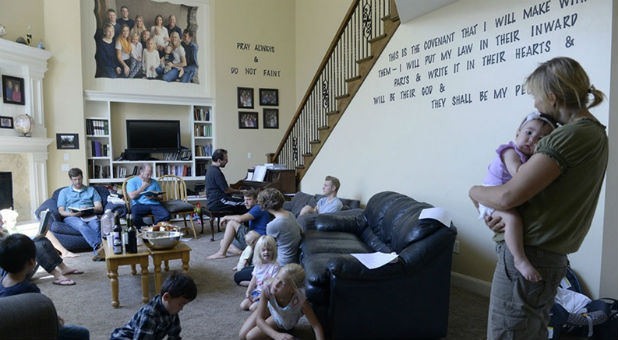False Prophet Gaining Steam Among a ‘Remnant’ Church
Don’t call Denver Snuffer Jr. a prophet, and don’t view his Remnant movement as a church.
Of course, it was his account about a face-to-face meeting with Jesus that branded him a prophetic figure in the first place. And his 2013 excommunication from the LDS Church for “apostasy” — arguing that after the death of Joseph Smith in 1844, the faith he founded no longer had the exclusive truth or divine authority — seems to have made Snuffer more popular with segments of dissatisfied Mormons.
Before long, hundreds of like-minded seekers traveled to hear Snuffer speak —in St. George, Phoenix and Boise—and poured out of their respective LDS pews to form “fellowships,” or small groups, usually gathering in houses and yearning for, well, something more.
They were mostly super-Mormons, zealots who gave their all to the faith. They taught in the LDS Church Educational System or worked at church-owned Brigham Young University. They served in temples. They dissected the Scriptures, looking for potent but hidden clues to Jesus’ Second Coming or keys to salvation.
Some devotees delved into holistic healing, piled up excessive food storage or launched apocalyptic preparations. Others found mainstream Mormon services too boring, too shallow to feed their spiritual hungering. They ached for more celestial manifestations, more holy works, more holy writ.
Whatever his listeners’ personal issues, Snuffer—who makes his home in Sandy, south of Salt Lake City—delivered a message that seemed to hit home: Mormonism’s hierarchical and bureaucratic structure had abandoned Smith’s heavenly visions and clarion calls to build Zion. Anyone, he said, could a have mystical encounter with deity—like early Latter-day Saints trumpeted—not just the guy at the top.
The Remnant, as some began to call themselves, would be radically democratic, a “federation of fellowships” with no clear leader, no rigid rules, no prescribed offices, no formal organization—setting themselves apart from what they see as the ultra-controlled and controlling LDS administration operating out of a grand old building and a skyscraper in downtown Salt Lake City.
By some estimates, the schismatic movement now includes between 5,000 and 10,000 followers in 49 states and several countries—mostly former or current members of The Church of Jesus Christ of Latter-day Saints. Some have been disciplined by the church; others continue to participate in the Utah-based faith, while sneaking off to fellowships on the side.
On Labor Day weekend, Snuffer will be in Boise at what the group is calling a Doctrine of Christ Conference, where hundreds of voters are expected to canonize a new set of scriptures, including a reworking of Mormonism’s foundational text, the Book of Mormon and its Doctrine and Covenants, a collection mostly of Smith’s revelatory writings.
“The last known major canonization was in 1672 by the Eastern Orthodox Church, so nothing like this has been seen in orthodox or Protestant Christianity in nearly 350 years,” Chris Hamill, a spokesman for the project, says in a news release. “Not even the Mormon church, or any of its offshoots, ever formally canonized (or accepted by common consent of the membership) all of their scriptures. … This is a very important historical development.”
“Things are happening fast,” says Remnant participant Ken Jensen of Sandy. “The work of God is afoot.”
How Worried Are Mormon higher-ups?
The LDS Church declined to comment on Snuffer or his movement, but an internal 2015 presentation to the faith’s apostles (as provided by the website MormonLeaks) lists the Sandy attorney—along with Ordain Women, excommunicated podcaster John Dehlin, nagging church history questions and some church policies—among the individuals and issues leading some members away from the religion.
And many Mormons, especially in places such as Utah County; Davis County; Mesa, Arizona; and Boise, where Latter-day Saints are in the majority, are seeing formerly active members tear up family unity by joining the Snufferites. Their absence in their congregations is obvious and far more dramatic than others who simply slip away.
These folks challenge core Mormon principles and precedents—established over nearly two centuries of LDS expansion—and any notion of inspired organization.
Though theirs is still an all-male priesthood, they reject the Mormon notion that ties it to church office or leadership. Baptism is not about joining a church. They have created a GoFundMe account to buy land for a future temple, though it is unclear exactly what rituals might take place there. Tithing monies remain in local fellowships, used for the poor in their midst, and are not sent to any central headquarters. There isn’t one. They don’t believe polygamy—as Mormons understand it—came from God.
In fact, Snuffer denounces plural marriage and insists Smith never fully practiced it—even in the face of generally accepted historical evidence stating otherwise—though some polygamists belong to fellowships.
The 60-something Snuffer and these believers advocate “a new tide of open religious thought and worship that is highly individual,” Brent Edward writes in a news release about the Boise conference, “involving no paid clergy. … The faithful in this new school of thought believe that God is capable of revealing His word to anyone who earnestly seeks it, and when truth is discovered, it should be added to the canon of inspired writings.”
Still, the movement’s language and direction are far from clear.
“Remnant of what?” asks Daymon Smith, a Utah Valley University anthropologist who has studied Snuffer’s writings and assertions. “Many different Mormons finish that sentence in often divergent ways, generally in opposition to a larger church; and yet still seem to be part of a single movement.”
Remnant believers are found in two places, Smith says, “on social media, where many ideas can be discussed and wrestled over, or left vague, and in face to face meetings, where the rituals and practices of the emerging movement provide a sense of unity, of preserving something.”
Though Snuffer urges all to have their own pipelines to God, he is still the one they look to and quote. They refer to scores of his books, his lectures on Mormonism, his running commentary and blog and his public speeches.
“Denver’s words are highly regarded, not because he is the leading authority or single prophet to be submitted to,” Smith says, “but because he voices their own sentiments, aspirations and long-running criticisms of the LDS church.”
Some Remnant adherents believe Snuffer might be the “one mighty and strong” described in Mormon scripture as a powerful figure who will come in the last days to set God’s house in order.
40 Years in the Faith
As a young Air Force cadet in New Hampshire, the non-believing Snuffer found Mormonism and was entranced by founder Smith’s words in D&C 76, offering a glimpse of three heavens in the eternities.
“Here in majestic simplicity was a vision of things which had never been revealed about the afterlife,” he writes in a description of his conversion, “and the definition of ‘many mansions’ which was both clear and soul-stirring,”
On Sept. 10, 1973, Snuffer, a self-confessed sinner and skeptic, plunged into the waters of LDS baptism and soon began an intense study of Mormon beliefs. For the next few decades, he taught the weekly gospel doctrine class in six wards (or congregations) in four states, plus spoke at BYU Education Week and at the University of Utah’s LDS Institute of Religion.
Meanwhile, he earned a law degree from BYU, married, divorced, remarried and reared nine children from both marriages. Along the way, he was drawn to Mormonism’s more esoteric theories.
In 2006, the lawyer published The Second Comforter: Conversing With the Lord Through the Veil, which became an overnight sensation with Mormons who desired more mystical interactions. Within four years, he was attracting hundreds to his speeches up and down the Mormon corridor.
At least two volumes and many sermons after his foray into deep theological waters, the now-ponytailed preacher produced Passing the Heavenly Gift, a tome which spells out Snuffer’s reading of Mormon history based on scripture, including his hypothesis about the church losing its way after Smith perished. The future Remnant leader’s Mormon stake (or regional) president demanded that he pull back the book. The writer refused.
He learned he had been excommunicated by his ecclesiastical leaders in Sandy on Sept. 10, 2013—40 years to the day after his baptism.
“I was not a rebel,” he says in a recent interview. “I suspect there are people in my home ward and stake today who are unaware that I’ve ever written a book.”
Being excommunicated didn’t change his commitment to Mormonism, Snuffer says. He continued to attend LDS services with his wife, Stephanie, while stepping up his speaking schedule—and telling everyone who would listen, as he wrote on his blog at the time: “I will not start a church. Period. Won’t. Not now. Not later. Never.”
Now the couple is all-in with the Remnant.
Two years or so after the LDS Church booted him out, Snuffer joined forces with some followers who wanted to expunge Mormon scriptures of anything that they couldn’t trace explicitly to Smith. Gone were D & C sections that talked about church organization, priesthood offices and polygamy, replaced by a package of Snuffer revelations and tucked into a new volume known as Teachings and Commandments.
“Conspiracies have corrupted the records beginning among the Jews, and again following the time of my apostles, and yet again following the time of Joseph and Hyrum [Smith],” Snuffer says God told him. “As you have labored with the records, you have witnessed the alterations and insertions, and your effort to recover them pleases me and is of great worth.”
Wine and Worship
On a recent Sunday, a dozen members of a Remnant fellowship lounge on couches in Ken Jensen’s Sandy living room, with about the same number of children, some in arms, some sprawled across laps and some crawling on the floor. Print shirts, pants on women and flip-flops give it a casual feel.
A large staircase snakes up to the second floor, with black letters affixed to the wall, saying, “This is the covenant that I will make with them—I will put my law in their inward parts and write it in their hearts and will be their God, and they shall be my people.”
The bearded dad, a father of 11 who was excommunicated from the LDS Church in 2015 for apostasy, suggests they sing hymns, beginning with children’s pieces. So Taylor Child moves to a piano and plays “Jesus Wants Me for a Sunbeam.” After that, it’s the Mormon classic “I Am a Child of God” and “Jesus Once Was a Little Child.”
While waiting for one woman to go to a nearby store for a baby bottle, the group discusses a Remnant baptism from the previous night. By now, scores of former Mormons have been re-baptized as a symbol of their newfound beliefs, but not to become a member of a church.
Child, who has been with the movement for three years, conducted the ritual for his 8-year-old son, Aidan, and invited his Mormon parents to attend. It took place at a Saratoga Springs hot spring by full immersion.
“There was a really good spirit there,” he says before quipping: “It was good exposure for my parents, so they could see we are not all Satan-worshippers.”
At 79, LaPrele Jordan has been looking for a spiritual home in various faith groups. She left the LDS Church in 1990 to join James Harmston’s breakaway—and eventually polygamous—sect in Manti, but fled that, too.
“It’s been a long, long, long journey to find you guys,” says Jordan, who was among those baptized the day before. “I’ve finally found where I belong, and it’s so wonderful.”
More singing and then comes the sacrament.
Two piano benches are placed in the middle of the room. Bottles of wine (with grape juice for the children) and baskets of artisan bread are set upon them. They kneel and close their eyes. Some hold their hands with upturned, cupped palms or reach their arms heavenward.
Child offers traditional Mormon communion prayers, except saying “wine” rather than water—as modern Latter-day Saints do. He and others tear slabs of the bread. Each worshipper takes a hunk. The wine and grape juice are poured into plastic cups and served.
After all partake, they move on to discuss the new scriptures as well as a draft of the movement’s emerging “guidelines and standards.”
Jensen found Snuffer’s work in 2010, back when he was a practicing Latter-day Saint, and felt it was “over my head.”
Now the insurance salesman grasps Snuffer’s message and says he is amazed at “how incredibly patient and long-suffering Denver has been … and how willing to let others grow in understanding.”
As religious movements go, this one is in its infancy. Now comes the hard part: finding a balance between individuality and organization.
What’s the Appeal?
It was the Book of Mormon that propelled Jeff Savage into the Remnant movement.
Savage was born and reared in the LDS Church in California, often serving in leadership positions. He spent two years proselytizing for his faith in southern Chile; met his wife, Emily, at BYU and then married her in a Mormon temple.
When Savage went to the University of Illinois for graduate work, he discovered Snuffer’s “Second Comforter.”
“It was like finding a drink of water in the desert,” the gentle scholar says. “Denver interweaves scripture and prose together and does so masterfully.”
Savage returned to the Mormon scripture he had read maybe 25 times before. This go-around, he saw things he had never before noticed.
“It talks about the last days before Christ’s return,” Savage says. “It describes people who care about appearance and riches and churches ‘built up unto themselves.’ It says those churches have gone astray.”
Reading along with his wife, Savage says, the couple concluded such verses were “talking about us. Our church.”
They didn’t want to abandon the only faith they had ever known, so they kept their observations private and, after moving to South Carolina, took in both Mormon and Remnant services.
Meanwhile, Savage was asked to oversee the effort to create some “guidelines and standards” for the burgeoning movement.
Fast-forward to a hot summer night in early August at Salt Lake Community College’s Sandy campus. There, Savage presents his draft to a group of about 40 representatives—about half are women—from fellowships across Utah, with others tuning in via Skype.
Though there is a patina of civility, collegiality and cohesion, serious divisions percolate beneath the surface and occasionally erupt, including after a kneeling prayer to discover God’s will.
It’s not surprising, though, given that, to these believers, words matter—a lot—and each is entitled to hear heaven’s promptings.
Debating Revelation
During the nearly five-hour meeting, every word in Savage’s document is scrutinized, assessed, challenged and voted upon.
The first long debate is about whether to allow the words “or grape juice” to be included in the section describing how the fellowships should perform the sacrament.
Snuffer says it should be “wine,” one attendee argues, so why allow grape juice? Another woman insists that those coming out of Mormonism or conservative traditions might be uncomfortable with wine. Why not allow grape juice? After more than 20 minutes, it is added.
For these representatives, the LDS health code known as the “Word of Wisdom,” which forbids alcohol, tobacco, coffee and tea, is just that—wisdom, counsel, advice. It is not a requirement as it has become in Mormonism.
The longest and most vociferous debate is over the inclusion of four words: “Thus saith the Lord.”
Savage, who sits patiently by like a modern-day Thomas Jefferson watching others rip apart his Declaration of Independence, defends his use of those words, noting they were dictated by God.
Smith used the same “thus saith the Lord” phrase in sections of Mormonism’s D&C, but he was believed to be the only “prophet, seer and revelator” who could speak for God to the whole church.
In this case, these words came exclusively to Savage. Could his personal revelation stand for the collective fellowships, they wonder, or only for him?
After some time, Savage acknowledges to the group that the first attribution to the Lord is a passage that came to Snuffer. Savage was reluctant to make that known because Snuffer has declared he was not involved in the guideline-writing process.
After more than an hour, the group votes on the phrase, and, though not all agree, no one opposes it. Other parts of the document are approved, disapproved or tabled. During the lengthy discussions, Snuffer’s name is invoked again and again as authoritative.
The notion of all fellowshippers getting their own revelations, including ones that may contradict others, is still an unsettling, new idea, Savage says. “We are transitioning out of revering the LDS hierarchy, but some still feel they can only trust Denver.”
Though he maintains he is just one voice among many, Snuffer will lay out what the group’s approach to history and scripture should be going forward in his “Prayer for Covenant.”
The words of it, Snuffer writes on a recent blog, “came by revelation from the Lord to me alone.”
But don’t call him a prophet. {eoa}
© 2017 Religion News Service. All rights reserved.




























































